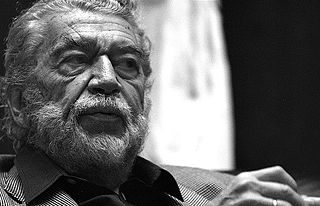Top Qs
Timeline
Chat
Perspective
Nouveau roman
1950s French literary movement From Wikipedia, the free encyclopedia
Remove ads
The Nouveau Roman (French pronunciation: [nuvo ʁɔmɑ̃], "new novel") is a type of French novel in the 1950s and 60s that diverged from traditional literary genres.[1] Émile Henriot coined the term in an article in the popular French newspaper Le Monde on May 22, 1957[2] to describe certain writers who experimented with style in each novel, creating an essentially new style each time. Most of the founding authors were published by Les Éditions de Minuit with the strong support of Jérôme Lindon.

Remove ads
Overview
Summarize
Perspective
Alain Robbe-Grillet, an influential theorist as well as writer of the Nouveau Roman, published a series of essays on the nature and future of the novel which were later collected in Pour un Nouveau Roman. Rejecting many of the established features of the novel to date, Robbe-Grillet regarded many earlier novelists as old-fashioned in their focus on plot, action, narrative, ideas, and character. Instead, he put forward a theory of the novel as focused on objects: the ideal nouveau roman would be an individual version and vision of things, subordinating plot and character to the details of the world rather than enlisting the world in their service.[3]


A group of writers dubbed Nouveaux Romanciers, "new novelists", appeared in the mid-1950s: Alain Robbe-Grillet, Claude Simon, Nathalie Sarraute, Michel Butor and Robert Pinget. The style had different approaches but generally rejected the traditional use of chronology, plot and character in fiction, as well as the omniscient narrator. The Nouveau Roman authors were open to influences from writers such as William Faulkner and the cinema. Both Robbe-Grillet and Marguerite Duras, whose 1958 novel Moderato cantabile was in the style of the nouveau roman, also contributed to the French New Wave style of filmmaking.[4]
Alain Robbe-Grillet became an elected member of the Académie française on 25 March 2004, succeeding Maurice Rheims at seat No. 32. Claude Simon, the 1985 Nobel laureate in Literature, is often identified with the Nouveau Roman movement.
The Nouveau Roman literary movement and the novels themselves were mainly theorized by Jean Ricardou,[5] who, in addition to his well-known theoretical works – Problèmes du Nouveau Roman (1967), Pour une théorie du Nouveau Roman (1971), Le Nouveau Roman (1973), Nouveaux problèmes du roman (1978) – also published several nouveaux romans himself: L’Observatoire de Cannes (1961), La Prise de Constantinople (1965, Feneon prize for literature in 1966), Les Lieux-dits, petit guide d’un voyage dans le livre (1969). Besides his own writing, he organized, directed and published the acts of several conferences on the nouveau roman, including the famous 1971 conference and debate at Cerisy, published in two volumes: Nouveau roman : hier, aujourd’hui, indispensable for an understanding of the history of that important period of French literature. Just before his death in 2016, he was working on a book of interviews with Amir Biglari, in which he provides a complete, precise and objective account of the Nouveau Roman movement.
Remove ads
Authors in the style of the Nouveau Roman
Summarize
Perspective
Central writers and works
The following is based on the list from Les nouveaux romanciers : étude critique as well as La littérature française du XXe siècle.[6][7]
- Samuel Beckett: Molloy (1951), Malone Dies (1951), The Unnamable (1953)
- Maurice Blanchot: Thomas the Obscure (1941; revised 1950)
- Michel Butor: Passing Time (1956), Changing Track (1957)
- Jean Cayrol: Foreign Bodies (1959)
- Marguerite Duras: Moderato Cantabile (1958), The Ravishing of Lol Stein (1964)
- Louis-René des Forêts: The Bavard (1946)
- Claude Mauriac: The Dinner Party (1959), The Marquise Went Out at Five (1961)
- Claude Ollier: The Mise-en-Scène (1958), Law and Order (1961)
- Robert Pinget: Graal Flibuste (1956), Monsieur Levert (1959), The Inquisitory (1962)
- Alain Robbe-Grillet: The Erasers (1953), The Voyeur (1955), Jealousy (1957)
- Nathalie Sarraute: Martereau (1953), The Planetarium (1959), The Golden Fruits (1963)
- Claude Simon: The Wind (1957), The Grass (1958), The Flanders Road (1960)
Parallel and later figures (1960s)
France
- Jean-Marie Gustave Le Clézio: The Interrogation (1963)
- Georges Perec: Things: A Story of the Sixties (1965)
- Jean Ricardou: L'Observatoire de Cannes (1961), La Prise de Constantinople (1965)
- Philippe Sollers: The Park (1961)
- Monique Wittig: The Opoponax (1964)
Canada
- Hubert Aquin: Next Episode (1965)[8]
- Gérard Bessette: Not for Every Eye (1960), Incubation (1965)[8]
- Jacques Godbout: L'Aquarium (1962)[8]
United Kingdom
- Christine Brooke-Rose: Out (1964), Such (1966)[9][10][11]
- B. S. Johnson: Trawl (1966), The Unfortunates (1969)[12][11]
- Ann Quin: Berg (1964)[11]
Italy
- Italo Calvino: Cosmicomics (1965)[13]
Argentina
- Julio Cortázar: Cronopios and Famas (1962), 62: A Model Kit (1968)[13]
United States
The critic Benjamin Libman has argued that the Nouveau Roman exerted a profound influence upon Susan Sontag and the development of postmodern fiction in the United States.[14]
Remove ads
The Nouveau Roman and the Left Bank
The Nouveau Roman style also left its mark on the screen as writers Marguerite Duras and Alain Robbe-Grillet became involved with the Left Bank film movement (often labelled as part of the French New Wave). Their collaboration with director Alain Resnais resulted in critical successes such as Hiroshima mon amour (1958) and Last Year at Marienbad (1961). They would later go on to direct their own films.[15]
Influenced by these films, French courses in North America during the 1960s and 1970s often included works by Nouveau Roman authors such as Alain Robbe-Grillet's La Jalousie (1957), Michel Butor's La Modification (1957), Nathalie Sarraute's Le Planetarium (1957) and Marguerite Duras' Moderato Cantabile (1958).[citation needed]
See also
References
Bibliography
Wikiwand - on
Seamless Wikipedia browsing. On steroids.
Remove ads
